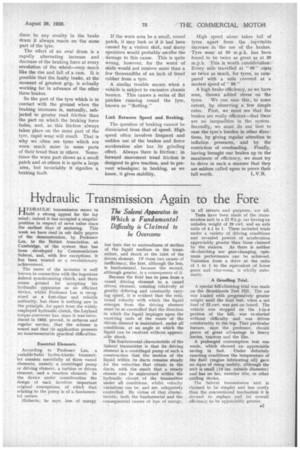Hydraulic Transmission Again to the Fore H YDRAUL1C transmission seems to
Page 41

If you've noticed an error in this article please click here to report it so we can fix it.
1 Ihold a strong appeal for the lay mind ; indeed it has occupied a singular position in respect of news value since the earliest days of motoring. This week we have read in oiir daily papers of the demonstration, by Professor Lea, to the British Association, at Cambridge, of the system that has been developed by Commendatore Salerni, and, with few exceptions, it has been treated as a revolutionary achievement.
The name of the inventor is well known in connection with the ingenious i+alerni synchronizing clutch, and there seems ground for accepting his hydraulic apparatus as an efficient device, whilst Professor Lea is recognized as a first-class and reliable authority, but there is nothing new in the principle, for apart from the widely employed hydraulic clutch, the Leyland torque converter has, since it was introduced in 1933. proved, in arduous and regular service, that the scheme is sound and that its application presents no insurmountable practical difficulties.
Essential Elements.
According to Professor Lea, a variable-tatio hydro-kinetic transmitter consists essentially of three vaned elements, namely a centrifugal pump or driving element, a turbine or driven element, and a reaction element. In the device under consideration the design of each involves important original conceptions, of which that relating to the pump is of a fundamental nature.
Hitherto, he says, loss of energy
has been due to unsteadiness of motion of the liquid medium in the transmitter, and shock at the inlet of the driven element. Of those two causes of inefficiency, the first, although the less, is fundamental, because the second, although greater, is a consequence of it.
Because the fluid has to pass from a vaned driving element to a vaned driven element, rotating relatively at greatly differing and constantly varying speed, it is evident that the rotational velocity with which the liquid emerges from the driving element must be so controlled that the direction in which the liquid impinges upon the receiving ends of the vanes of the driven element is maintained, under all conditions, at an angle at which the liquid can be received without appreciable shock.
The fundamental characteristic of the Salerni transmitter is that its driving element is a centrifugal pump of such a construction that the motion of the liquid within its ducts remains steady for the velocities that obtain in the ducts, with the result that a steady stream can be maintained within the hydraulic circuit of the transmitter under all conditions, whilst velocity variations can be, and are, adequately controlled. By virtue of that characteristic, both the fundamental and the consequential causes of loss of energy,
to all intents and purposes, are nil.
Tests have been made of the transmission unit in a 21.6 h.p. car having an unladen weight of 29 cwt. and an axle ratio of 4.1 to 1. These included trials under a variety of driving conditions and revealed powers of acceleration appreciably greater than those claimed by the makers. As there is neither de-clutching nor gear-changing, optimum performance can be achieved. Variation from a drive at the ratio of 1 to 1 to the equivalent of lower gears and vice-versa, is wholly automatic.
A Gruelling Trial.
A special hill-climbing trial was made on the Brooklands Test Hill. The car was loaded with progressively greater weight until the final test, when a net load of 22 cwt. was put on board. The vehicle was stopped on the 1-in-4 portion of the hill, was re-started without difficulty and was driven comfortably to the top. That particular feature, says the professor, should prove of great advantage in heavy lorries, tractors and the like.
A Prolonged consumption test was made, which showed an appreciable saving in fuel. Under definitely exacting conditions the temperature of the fluid (engine lubricating oil) gave no signs of rising unduly, although the unit is small (13 ins, outside diameter) • and has no fan, exterior ribs, or other cooling device.
The Salerni transmission unit is claimed to be simpler and less costly than the conventional mechanism it is devised to replace and its overall efficiency to be appreciably greater.




















































































